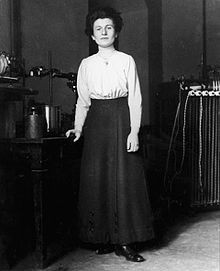Hedwig Kohn
Hedwig Kohn (born April 5, 1887 in Breslau ; † November 26, 1964 in Durham , North Carolina , USA ) was a German physicist . Along with Lise Meitner and Hertha Sponer, she was one of only three women who achieved a habilitation in physics in Germany before the Second World War . Like Meitner and Sponer, she had to flee Germany at the time of National Socialism . She moved to the USA and became a professor of physics there.
Life
Hedwig Kohn came from a wealthy German-Jewish family. She was the daughter of Helene Hancke and Georg Kohn, who was a textile merchant in Breslau.
In 1906 she began to study at the University of Breslau , initially as a guest student, as official enrollment for women was not yet possible at that time. She received her doctorate in 1913 with a thesis on the nature of the emission of metal vapors glowing in flames . In 1914 she became an assistant at the Physics Institute of the University of Wroclaw, where she took on extensive tasks when most of her male colleagues were called up to the army at the beginning of the First World War . She worked with Otto Lummer on a new edition of Müller-Pouillet's textbook on physics . Her extensive contributions to this project were recognized as her habilitation in 1930. A little later she became a private lecturer.
In 1933 the law to restore the civil service was passed; all of the university's Jewish scholars were dismissed. The director of the Physikalisches Institut, Clemens Schaefer , tried to prevent Hedwig Kohn from being released by writing a letter to the university management on June 22, 1933, but was unsuccessful. On September 7, 1933, her teaching license was revoked. Kohn emigrated to Switzerland, where she worked at the light-climatic observatory in Arosa and as an industrial consultant . In 1938 the Women's College of the University of North Carolina , Sweetbriar College in Virginia and Wellesley College assured her teaching positions for one year each, which enabled her to enter the United States. At Wellesley College, she became an assistant professor in 1945 and a full professor three years later. In 1952 she went to Duke University in Durham (North Carolina) , where Hertha Sponer was also working at the time. When Hedwig Kohn retired at 65, Sponer made it possible for her to work on a research project at Duke University, where she continued to research and teach for another 12 years.
Her specialty was optics , she also worked on the processes of pyrometry and spectrometry as well as the development of light sources.
On the occasion of her 132nd birthday, Google dedicated a doodle to Hedwig Kohn .
literature
- Renate Strohmeier: Lexicon of natural scientists and women of Europe. From antiquity to the 20th century. Thun, Frankfurt am Main 1998, ISBN 3-8171-1567-9 , p. 159 ( at Google Books ).
- Brenda Winnewisser: Hedwig Kohn - A Physicist of the Twentieth Century. In: Physik Journal Nr. 2, 2003, pp. 51-55 ( PDF file, 1.3 MB ).
Web links
- Literature by and about Hedwig Kohn in the catalog of the German National Library
- Hedwig Kohn in the Jewish Women's Archive , accessed April 5, 2012 (English)
Individual evidence
- ↑ Hedwig Kohn born on
- ↑ Susanne Heim , Götz Aly : The persecution and murder of European Jews by National Socialist Germany 1933–1945. Volume 1: German Empire 1933–1937. 2008, ISBN 3-486-58480-4 , pp. 198-199.
- ^ Former Duke physicist survived the Holocaust. Retrieved April 5, 2019 .
- ↑ Information on the Google Doodle
| personal data | |
|---|---|
| SURNAME | Kohn, Hedwig |
| BRIEF DESCRIPTION | German physicist |
| DATE OF BIRTH | April 5, 1887 |
| PLACE OF BIRTH | Wroclaw |
| DATE OF DEATH | November 1964 |
| Place of death | United States |
